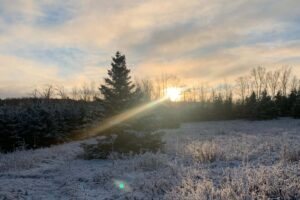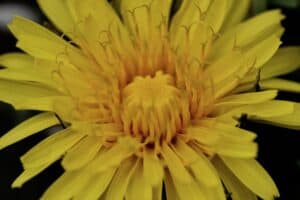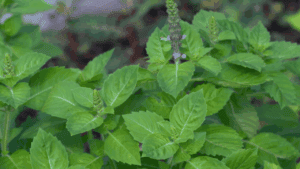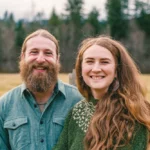Table of Contents
Well that one thought snowballed into what’s turned into a majorly extensive remodeling of basically the entire house! (It’s amazing all the not-so-pleasant surprises you find once you start opening up walls…)
One of those surprises was found upstairs when I tore out all the drywall and discovered that one of the previous owners thought it was a good idea to cut all the scissor trusses to make some room to put a little attic room in.
If you don’t know what trusses are, basically they’re the primary structural component of a house that holds your entire roof up.
And about 80% of them were completely cut out…
Which means that our entire roof over the past who knows how many years started caving in on itself.
Yikes!!
Our quick little spruce up remodel project has now turned into a pretty major overhaul in which our entire roof had to get torn off and rebuilt completely. Not a fun situation, especially in the middle of a super cold winter!
I was up there the other day looking around and thinking about what made that person think that it was okay to just start cutting away structural components of a house. And I realized that it’s a similar kind of thinking that herbalists can fall prey too… and that’s an allopathic mindset.
So I thought I’d share some of the thoughts and insights I had looking at my disaster of a house and how it applies to our approach to herbal medicine. Here they are, my top herbal lessons learned from a house remodel:
Don’t Just Patch the Symptom
When the previous owner of my house cut those trusses, they took a short-cut, an easy way out. While it may have fixed their acute problem (symptom) in the short-term, it didn’t address the core underlying problem and actually ended up creating a much larger problem in the long-term.
This can happen when we’re addressing our clients concerns as well. It’s easy for us to tunnel vision in on the acute symptom and start thinking in terms of what herbs are “good for” that symptom.
We give Willow bark for the headache…
Or some Turmeric for their inflammation…
Knowing what herbs are remedial for certain conditions or symptoms is helpful information, but for us to be truly effective herbalists, we have to know much more about our remedies than that so we can get more specific in our administration of remedies. We don’t just want patch the symptom, we want to treat the root cause.
The worse case scenario is that we put an herbal band-aid on, the symptom seems to get better, but the core issue continues to linger, is driven deeper into the body, and manifests later on as a much more serious condition.
Like my roof needing to get completely torn off and rebuilt…
Think in Terms of of Wholeness
When we just look at the symptom, we run the risk of overlooking the whole person. We don’t think in terms of the entire system, and how that local, superficial symptom might be an indication of something much deeper going on in the body that must be addressed in order for healing to occur.
So when we’re working with a person we have to look at their whole life. What do they put into their body on a regular basis? What’s the state of their emotions and thoughts? What kinds of beliefs and perceptions do they hold to be true? What’s their overall lifestyle?
Ultimately working with people is like hunting for a pattern. We’re looking for how all the parts connect to create the situation they’re currently in. And when we look at a person in that way we start to understand the entire system on a much deeper, more vital level, and thus how that symptom is just one piece of a much greater pattern of wholeness.
Because when you just look at the symptom, you can end up making a mistake like cutting the trusses….
Short-Term vs. Long-Term
The decisions we make each and every day affect us in a wide variety of ways. Some of them we see the consequences of quite quickly, others slowly build up over time. When that home owner cut those roof trusses, they probably didn’t realize that over time it would require the entire top of the house to be rebuilt because the roof was caving in!
It’s kind of similar with our daily lives. Eating a really poor diet may not seem like that big of a deal in the short-term, but after decades of it, we start to really feel the detrimental effects. Or perhaps we get really sick and end up needing to take a round of antibiotics. It helps us in the short-term, but over time it may lead to other problems.
This is why as herbalists, it’s important that we understand timelines as we work with our clients. Health problems usually don’t surface overnight. They are often the result of an unfathomable number of decisions we make throughout our lives. Our job, as mentioned in the previous point, is to search for the pattern. To investigate the lives of the people we serve and find those different influential decisions and turning points in our lives that are contributing to our current state of health, or lack of health.
This point also makes me think about the effects of medicinal plants. One important way of understanding a plant and how it functions in the body is the difference between its short-term and long-term effects. This is especially true when we consider how a plant will influence our overall constitution.
For example, if someone has an overly damp condition in the body, using a remedy like Nettle leaf (Urtica dioica) will be an excellent plant to relieve this dampness through its diuretic and astringent properties. This can be remedial in the short-term, but if used for too long, it may lead to a pattern of dryness in the body.
Another example of this would be looking at Cayenne pepper (Capsicum annuum). I always found it interesting and a bit counterintuitive that people in really hot climates eat so much spicy food. In the very short term effect of Cayenne, it warms up the digestion, stimulates circulation of blood, and pushes everything out from the core to the periphery as it activates the inner Fire Element of the body. Thus we think of it primarily as a warming remedy.
But, as all that blood flows out to the surface, capillary beds dilate, and the pores open, you suddenly start breaking a sweat, which then cools you down. This is why you usually don’t want to eat super spicy foods that make you sweat and then go outside, because you’re all opened up and that cold can get in. So Cayenne has a short-term warming effect but a longer-term cooling effect.
This is an important consideration when working with plants and how they will affect you physiologically and energetically in a short-term period of time vs. a long-term period of time.
The Importance of Onset
My last big herbal lesson learned from my house remodel has to do with the importance of understanding the onset. As mentioned previously, sometimes we make decisions that have detrimental effects on our long further into the future. This is why when consulting with someone, we have to really dig in deep to understand when their symptom/condition/problem emerged, what was going on in their lives at that time, and how we can remedy it.
Sometimes people have an experience in their life that changes everything forever. “After I traveled to India and came back my digestion was never the same.” I’ve heard that one a time or two…
This lends us great insight into possible root causes of a problem and how we can approach remediating it. One trick I learned from Matthew Wood, is that sometimes the best remedy to give someone now is the remedy you would have given them when the problem first began, even if it was decades ago! This can especially be true for treating traumatic events from the past – whether psychological and physical – but really any kind of health condition.
One situation where this worked very well was when I had a client with chronic neck and back pain. She’s worked with your typical anodyne, pain relieving, antispasmodic type remedies, which helped a little, but never really got to the root of the issue. Once I learned it all started after she’d gotten whiplash from a really bad car accident, I knew that Black Cohosh (Cimicifuga racemosa) was the most indicated remedy… the one I would have given her if she’s come to see me right after the accident. That remedy helped her on levels no other plant touched, because it got back to the root cause that developed at the onset.
One thing I always like to say about walking a healing path, is that it’s all about life. It’s all about paying attention to our own lives, the life within the plants, the life within Nature, and learning directly from it.
And sometimes you can find lessons that relate back to your plant path in the strangest of places… even staring at the tarp that’s the temporary roof over your head.







